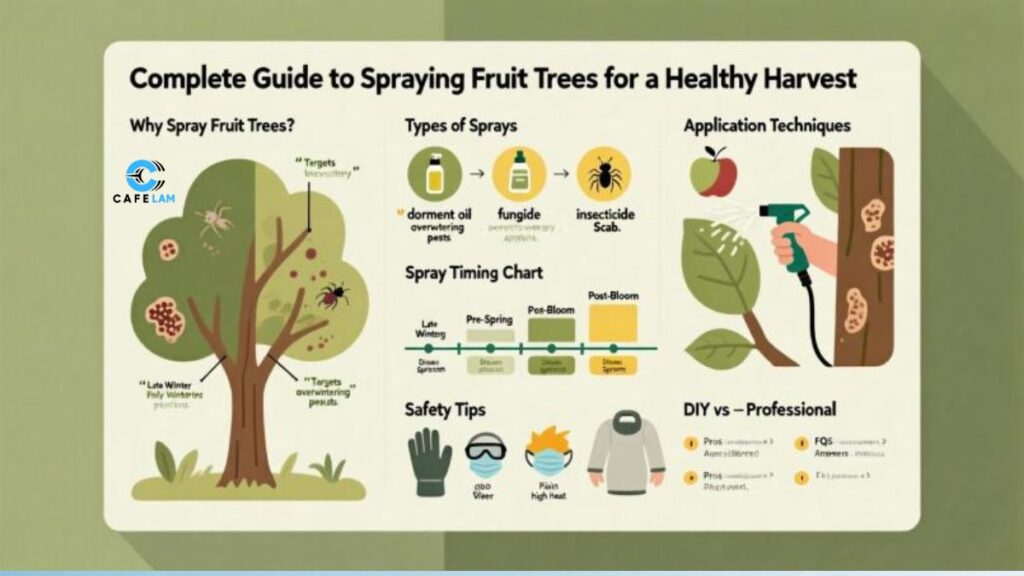Spraying fruit trees is one of the most effective ways to protect your orchard from pests, diseases, and environmental challenges. When done correctly, this practice can dramatically improve fruit quality, increase yields, and extend the life of your trees. Many home gardeners feel overwhelmed by the complexity of tree care, but understanding the basics of spraying fruit trees can transform your gardening success.
This comprehensive guide will walk you through everything you need to know about spraying fruit trees effectively and safely. From timing and techniques to product selection and safety measures, you’ll discover how to give your fruit trees the protection they need to thrive.
Understanding the Importance of Spraying Fruit Trees
Fruit trees face numerous threats throughout the growing season, from aphids and scale insects to fungal diseases and bacterial infections. Without proper protection, these issues can devastate entire harvests and weaken trees over time. Spraying fruit trees creates a protective barrier that prevents many problems before they start.
Regular spraying programs help maintain tree health by addressing both visible issues and potential threats. Healthy trees produce better quality fruit with improved flavor, appearance, and storage life. Additionally, preventive spraying often costs less than treating severe infestations or diseases after they become established.
The key to successful spraying fruit trees lies in understanding what threats your specific trees face and when they’re most vulnerable. Different fruit varieties have unique susceptibilities, and local climate conditions play a major role in determining the best spray schedule.
Essential Types of Sprays for Fruit Trees
Dormant Oil Sprays
Dormant oils are applied during the tree’s dormant season, typically in late winter or early spring before buds begin to swell. These oils suffocate overwintering insects and their eggs, including scale, mites, and aphids. The timing is crucial because applying dormant oils too late can damage emerging buds and leaves.
Horticultural oils work by creating a thin film over insects and their eggs, blocking their ability to breathe. This method is environmentally friendly and doesn’t leave harmful residues on fruit. Most dormant oils are petroleum-based or plant-based products that break down naturally over time.
Fungicide Applications
Fungal diseases pose serious threats to fruit trees, especially in humid climates or during wet seasons. Common fungal problems include apple scab, brown rot, and powdery mildew. Preventive fungicide spraying is much more effective than treating established infections.
Copper-based fungicides are popular organic options that work well for preventing many fungal diseases. Synthetic fungicides offer broader spectrum protection but require careful attention to pre-harvest intervals and application rates. Regular fungicide spraying during critical periods can prevent most fungal issues.
Insecticide Treatments
Insect pests can quickly damage fruit and weaken trees if left unchecked. Spraying fruit trees with appropriate insecticides targets specific pests while minimizing harm to beneficial insects. Timing is essential because many insecticides work best when pests are in vulnerable life stages.
Organic insecticides like neem oil and insecticidal soaps provide effective pest control with minimal environmental impact. These products break down quickly and don’t accumulate in soil or fruit. Synthetic insecticides may be necessary for severe infestations but should be used judiciously.
Critical Timing for Spraying Fruit Trees
| Season | Spray Type | Target Issues | Application Notes |
| Late Winter | Dormant Oil | Scale, Mites, Overwintering Pests | Apply before buds swell |
| Early Spring | Fungicide | Disease Prevention | Start before leaf emergence |
| Pre-Bloom | Insecticide | Emerging Pests | Avoid during bloom to protect pollinators |
| Post-Bloom | Combination Sprays | Ongoing Pest/Disease Management | Continue through growing season |
The timing of spraying fruit trees directly impacts effectiveness and safety. Dormant season applications target overwintering pests when trees are least vulnerable to spray damage. Spring applications focus on preventing diseases as conditions become favorable for fungal growth.
Summer spraying requires careful attention to weather conditions and pollinator activity. Hot, sunny days can cause spray burn, while windy conditions reduce effectiveness and increase drift. Early morning or late evening applications often provide the best results.
Proper Application Techniques
Effective spraying fruit trees requires thorough coverage of all plant surfaces, including the undersides of leaves where many pests hide. Use a pump sprayer or hose-end sprayer that provides adequate pressure for good coverage. Start from the bottom of the tree and work upward, ensuring spray reaches all branches and foliage.
Spray until liquid begins to run off leaves, but avoid excessive application that wastes product and increases environmental impact. Maintain steady movement to prevent over-concentration in any area. Pay special attention to branch crotches and other areas where pests commonly shelter.
Proper mixing is crucial for spray effectiveness and tree safety. Always read and follow label instructions exactly, as improper concentrations can damage trees or fail to provide adequate protection. Use clean equipment and fresh mix for each application to maintain product integrity.
Essential Safety Considerations
Personal protective equipment is mandatory when spraying fruit trees, regardless of the products used. Wear long sleeves, long pants, gloves, and eye protection at minimum. Respiratory protection may be necessary for certain products or when spraying overhead branches.
Weather conditions significantly impact spray safety and effectiveness. Avoid spraying during windy conditions to prevent drift onto non-target areas. High temperatures can increase chemical volatility and cause plant damage. Rain within 24 hours of application can wash off products before they become effective.
Store all spray products in original containers in a cool, dry location away from children and pets. Dispose of empty containers according to local regulations, and never reuse pesticide containers for other purposes. Keep detailed records of all applications for future reference.
Common Mistakes to Avoid
Many gardeners make the mistake of waiting until problems become severe before spraying fruit trees. Preventive applications are much more effective and less expensive than curative treatments. Start spray programs early in the season and maintain consistent schedules for best results.
Using the wrong products or incorrect concentrations can damage trees or fail to control target pests. Always identify problems correctly before selecting treatment options. When in doubt, contact local extension services or certified arborists for guidance.
Neglecting spray equipment maintenance reduces effectiveness and wastes money. Clean sprayers thoroughly after each use and calibrate equipment regularly to ensure proper application rates. Replace worn nozzles and seals that can cause uneven coverage or equipment failure.
Benefits of Professional vs. DIY Spraying
Professional tree care services bring expertise, equipment, and liability insurance that many homeowners lack. They understand complex spray schedules, product compatibility, and local pest pressures. For large orchards or valuable trees, professional spraying fruit trees services often provide better long-term value.
DIY spraying offers cost savings and scheduling flexibility for smaller operations. Home gardeners can learn effective techniques with practice and attention to detail. Start with simple programs and expand knowledge gradually as experience grows.
The decision between professional and DIY approaches depends on tree numbers, budget, available time, and comfort level with pesticide applications. Many successful orchardists combine both approaches, handling routine maintenance while calling professionals for specialized treatments.
Conclusion
Successfully spraying fruit trees requires knowledge, planning, and consistent execution, but the rewards of healthy trees and abundant harvests make the effort worthwhile. Start with a solid understanding of your trees’ specific needs and local pest pressures. Develop a seasonal spray schedule that addresses both preventive and corrective treatments.
Remember that spraying fruit trees is just one component of comprehensive tree care. Combine spray programs with proper pruning, fertilization, and cultural practices for optimal results. With patience and attention to detail, you can develop the skills needed to maintain healthy, productive fruit trees for years to come.
ALSO READ THIS POST: Banana Bread Old Fashioned – Classic Recipe & Baking Tips
Frequently Asked Questions
Q: Can I spray fruit trees when they’re flowering?
A: Avoid spraying during bloom to protect pollinators. Wait until petals fall before resuming spray programs.
Q: How often should I clean my spray equipment?
A: Clean thoroughly after every use and perform deep cleaning monthly to prevent product buildup and equipment damage.
Q: Is it safe to eat fruit immediately after spraying?
A: Always follow pre-harvest interval guidelines on product labels, which specify minimum waiting periods before harvest.
Q: Can I mix different spray products together?
A: Only mix products specifically labeled as compatible, as some combinations can reduce effectiveness or cause plant damage.
Q: What’s the best time of day for spraying fruit trees?
A: Early morning or late evening applications reduce evaporation and minimize stress on trees and beneficial insects.







